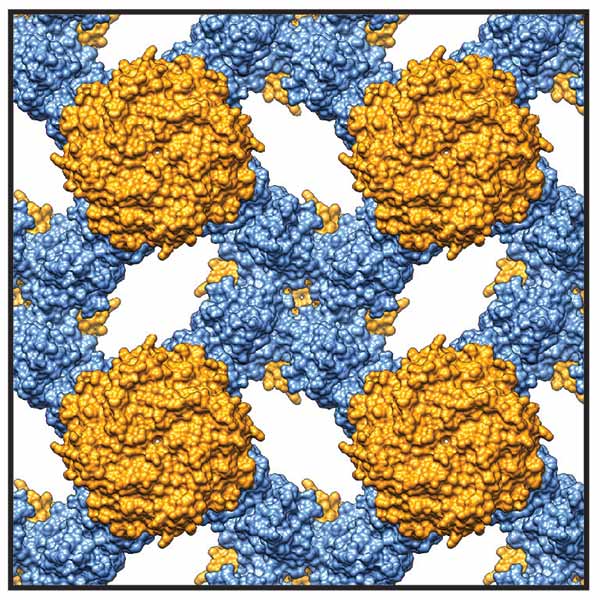
Chemists at UC San Diego have created an “adaptive protein crystal” with a counterintuitive and potentially useful property: When stretched in one direction, the material thickens in the perpendicular direction, rather than thinning as familiar materials do. And when squeezed in one dimension, it shrinks in the other rather than expanding, and gets denser in the process.
This strange behavior could prove useful for the sole of a running shoe that thickens for greater shock absorption as heel collides with pavement, for example, or to construct body armor that strengthens when a bullet strikes.
“It’s a property, called ‘auxetic,’ that has been not been previously demonstrated at the molecular level through design,” said Akif Tezcan, a professor of chemistry and biochemistry at UC San Diego who headed a team of researchers that detailed its invention in an advance online paper in this week’s Nature.
Tezcan’s group created a sheet-like crystal made of proteins connected in a regular, repeating pattern. They chose a protein called RhuA for its square shape and used it like tiles to make their material.
“We found a way to create strong, flexible, reversible bonds to connect the protein tiles at their corners,” Tezcan said. The flexibility allows the tiles to rotate to open spaces for a porous material or to close up in a kind of adaptable sieve.
Stretching or compressing the material in one directions causes the connected protein tiles to rotate in unison, resulting in a corresponding expansion or contraction in the opposite directions. The Poisson ratio, usually a positive measure for normal materials that stretch and shrink in opposition, describes this relationship. Tezcan’s group measured a Poisson ratio of -1 for their material, a value at the thermodynamic limit of what is possible.
The crystals form perfectly with almost no tiles missing or ajar, and the material is self-healing. Protein tiles easily pop into place, given the right chemical conditions.
“This is protein design using a highly chemistry-based approach,” Tezcan said, noting that the materials are made via a streamlined, minimalistic design strategy that requires few alterations to the protein building blocks.
“These materials are very easy to make, yet provide many new research directions both in terms of materials applications and understanding the fundamental principles of nanoscale self-assembly,” he added.
Other authors of the paper include Yuta Suzuki in Tezcan’s research group, David Restrepo and Pablo Zavattieri of Purdue University, Timothy Baker, a professor of chemistry and biochemistry and biology at UC San Diego, and Giovanni Cardone in Baker’s research group.
Learn more: ‘Adaptive Protein Crystal’ Could Form New Kind of Protective Material
The Latest on: Adaptive Protein Crystal
[google_news title=”” keyword=”Adaptive Protein Crystal” num_posts=”10″ blurb_length=”0″ show_thumb=”left”]
via Google News
The Latest on: Adaptive Protein Crystal
- Brain Injury Newson May 1, 2024 at 5:00 pm
The study found two critical groups of spinal cord neurons, one necessary for new adaptive learning ... Study Reveals a Protein Called Snail May Play a Role in Healing Brain Injury Dec. 11 ...
- Microgravity-grown crystals reveal new insights into protein structureson April 29, 2024 at 7:19 am
Biochemists have long been working around a blind spot when it comes to proteins. They know that hydrogen constitutes nearly half of the atoms in proteins, but how they contribute to protein function ...
- Protein Crystallization & Crystallography Market Role of Machine Learning in Data Analysis Innovations and Trendson April 26, 2024 at 4:37 am
report_id=bw1231 Protein Crystallization & Crystallography Market is valued approximately USD 1 billion in 2019 and is anticipated to grow with a healthy growth rate of more than 8.9 % over the ...
- 9 Best Protein Powders of 2024, According to Registered Dietitianson April 9, 2024 at 5:00 pm
Here’s our process. Healthline’s testers and dietitians reviewed and chose the best protein powders. See the top picks that made our list. Whether you’re trying to lose weight, build muscle ...
- BIOL.4892 Crystallography and Structural Bioinformaticson March 9, 2024 at 4:34 pm
The course will cover the fundamental knowledge about x-ray physics, instrumentation and geometrical diffraction, protein crystallization, macromolecular data collection and processing, phase ...
- Protein Crystal Image (IMAGE)on September 10, 2022 at 2:48 am
An example of a crystalline outcome from the high-throughput screening laboratory at Hauptman-Woodward. These are the types of images that will be used for feature extraction by the World ...
- 33 High-Protein Breakfast Ideas for All-Day Energy, According to Dietitianson June 21, 2022 at 9:47 pm
A morning that starts with a high-protein breakfast is a good one, indeed. It is sure to keep hunger in check: Studies show that eating a high-protein breakfast kept subjects snacking throughout ...
- Billy Crystalon May 29, 2018 at 2:53 pm
Whoopi Goldberg, Billy Crystal Hold Back Tears While Honoring 'Brother' Robin Williams at Kennedy Center Honors Billy Crystal Returns to Katz's Deli for the First Time Since Filming Iconic When ...
- Engineering and Innovative Technology Developmenton March 13, 2016 at 5:20 am
HDPCG (High Density Protein Crystal Growth) is intended to demonstrate the scientific and commercial value of protein crystallization on a long-duration microgravity mission. HDPCG consists of ...
- Handheld HDPCGon February 28, 2016 at 7:46 am
The main purpose of the Handheld HDPCG (High Density Protein Crystal Growth) experiment is to grow large, well ordered protein crystals in microgravity for highly medically relevant proteins that are ...
via Bing News









